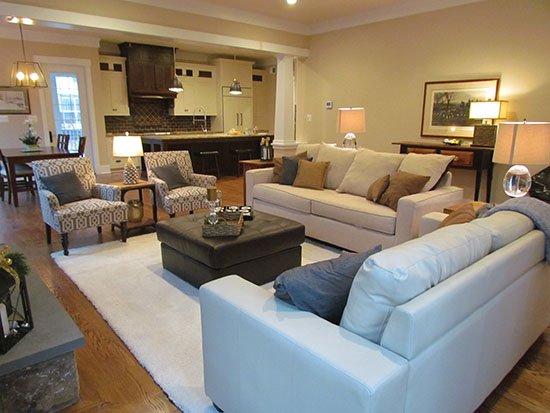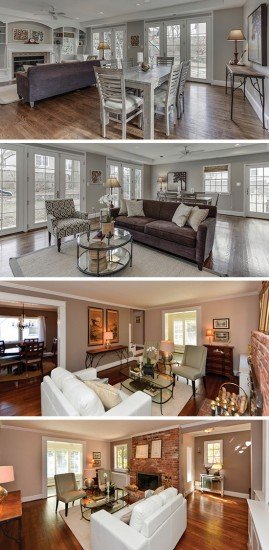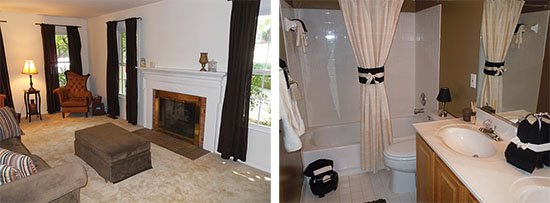
Photo courtesy of Pat Baldwin.
By Jennifer Shapira
Stephanie Kelley must have five white sofas in her extensive inventory. “It’s funny,” says the home stager and owner of Refined Design in Fairfax. “We call them our workhorses because they go everywhere.”

In an occupied home, stagers will move the furniture around, creating more intimate conversation areas. Owners tend to put furniture around the perimeter of the room. Experts say that actually makes a room look smaller, not larger. Photo courtesy of Pat Baldwin.
With a careful eye to design, she trucks in the sofas and adds mix-and-match pieces to vacant houses. A personal record: She staged 13 homes that hit the market at once. Those dependable sofas, with their modern aesthetic, go with everything, she says, to create a comfy conversation perch.
Staging a home for sale is an art form. In fact, a number of professional stagers and real estate agents come from fine arts backgrounds, which allows them to show their appreciation in every listing.
Mary Anthony, a McLean-based Realtor with Keller Williams who teams up with stager Pat Haffey Baldwin, owner of Inspired Interiors, likens the art of staging to the quintessential department store experience.
“When you go into a department store, there’s music, there’s lighting, there are flowers and mannequins, displays, and everybody really gets excited because it puts you in a mood and tells a story. It’s the same thing with a house,” Anthony says. “When you go into a house with empty rooms that’s totally vacant, the house is kind of sad—it doesn’t have a personality; there’s no soul. It doesn’t have a story. You don’t have any feeling for who might have lived here or who could live here.”
And that’s the crux of staging: to create a warm, comfortable “I could live here” vibe—in both occupied and unoccupied homes—that also has wide appeal.
“With staging, you want people to linger,” says Kelley, because that means they can visualize themselves living there. “When they start to say, ‘Oh, well this could be so-and-so’s room,’ there’s a pretty good chance that [the home] is intended for them.”
Sharon Goetz, a Realtor for Keller Williams in Reston, stages each of her listings. “Staging is very different than decorating,” she says. “Decorating is putting personality into the space; staging is taking it out of the space so that it’s more generic and has more mass appeal.”
Thanks to HGTV, sellers have an idea of staging. They just don’t know how that translates into what buyers want, says Goetz, who works with a lot of first-time sellers. If you want to sell a townhouse, she says, that’s a home that’s likely to appeal to a first-timer buyer between the ages of 28 and 34.
Stagers always consider who might buy the home. For example, if it’s a one-bedroom condo, Kelley might set up a little bar and add some martini glasses. Or she’ll add art books to the shelves and travel magazines to coffee tables of a home that’s near museums and nightlife. If there’s a workout area, she might outfit it with a yoga mat and a handful of DVDs.
A staged home is not merely the result of a shopping list, though that can help. There is more to the art of staging than placing a pretty vase on a mantel. A stager walks through every room and devises a comprehensive plan. It will likely involve painting the walls in a fresh coat of something with universal appeal, in beiges, gray and greiges. If there’s wallpaper, that has to come down, says Goetz.
“I look at anything from the floor to the ceiling,” she says. She “shops the house” and moves furniture around to make rooms more inviting. For example: “Maybe the couch in the basement would look better in the family room. We just try to make it more appealing using their things.”
In general, people have too much clutter. “So if you’re moving, you need to be packing up your stuff anyway,” says Goetz. “You’re not selling your stuff; you’re selling your square footage.”
There will be homework. That’s the boot camp part, says Goetz. That could include marching orders to buy new lamps, downsize and donate unused clothes in the closets, weed out old volumes from bookshelves, even replace kitchen and bath fixtures. The house needs to show well at open houses and in photographs online.
For the DIY homeowner looking to sell, making those fixes can be a money-saver. For those who are hands-off, realtors and stagers work with contractors who can make repairs. And often, realtors will cover staging costs.
“I wouldn’t dream of selling a house that I didn’t go in and advise the sellers about how to clean it up,” says Anthony. “I cover the cost of staging because it’s that important to me.”
When homeowners take care of maintenance issues and complete any unfinished projects, prospective buyers notice. That gives the impression that the home is well-maintained, says Goetz. “So we want to make sure that it is.”
In an occupied home, stagers will move the owner’s furniture around, creating more intimate conversation areas. Owners tend to put furniture around the perimeter of the room. Experts say that actually makes a room look smaller, not larger.
“I call that centrifugal force decorating: the home ends up looking like a doctor’s waiting room,” says Baldwin. “Seating is too far apart to be conversational. I place the furniture to help enhance what they have, to increase the function of the home, make it more attractive and still have good traffic flow.”
Most stagers have robust inventories that include everything from small accessories like coffee table art books to bigger ticket items like tables and couches. After careful room-by-room deliberation, they add a side table here, a mirror there, some throw pillows to punch up an otherwise dull sofa. They will transform any interior—occupied or unoccupied—into a model home. Baldwin says most homeowners in this area already own nice pieces of furniture; it’s just a matter of helping them get the scale and placement right.
Baldwin cut her teeth on unoccupied estates where the owners had died. Agents tested her on transforming those homes and bringing them back to life, which she often cobbled together with mismatched furniture. She would accessorize with colors and artwork, always able to give the home a more youthful, current look.
“My job when I stage is to have the home speak for itself,” says Baldwin, a former real estate agent. “I want my staging to speak for the agent, how the agent would sell the home: ‘Notice a beautiful view out this window.’ ‘See how gracious this room is and what a lovely conversation area it has; it features this gorgeous fireplace,’ and ‘See how your art looks in this room.’”
When Baldwin previews a home, she asks: Is this working? “And the answer is no. That’s the only criteria I need,” she says. “Then I can go in and make a difference.”
Anthony has been known to take art from her own walls at home to display in a staged room in a home she’s selling. She keeps an extensive trove of furniture and accessories in her garage-based prop shop, where she’ll often dip into her own inventory.
She recalls a vacant contemporary home in Falls Church that changed hands after six months on the market. There was nothing left inside but lonely, black furniture. So when Anthony went in, she added celadon touches in flowers and candles and considered: Who might live here? Three weeks later it sold.
Anthony grows attached to the homes she stages and sells, even after only 30 to 60 days. “I have so much fun doing it. It’s just a fun challenge. I can hardly let go of the house,” she says. “The homeowner might have been there 15 or 20 years, but at settlement I feel like I’m losing a friend. It’s a real pleasure to have something fun to play with.”

Staging project by Sharon Goetz. Photo courtesy of Sharon Goetz.
Staging Tips
“The biggest crime is that people have too much stuff,” says Realtor and stager Sharon Goetz. If you’re planning to sell, experts agree it’s time to pare down and cut the clutter. Local real estate professionals recommend following these tips to make your home a quick sell and fetch top dollar.
• Give every room a purpose, says Stephanie Kelley, so that there’s no guessing game among potential buyers as to its use. Add a little desk to a niche for an instant office, or add a chaise to an oddball cutout for a reading nook.
• Paint. This is absolutely crucial to freshening up any home’s interior. Select neutral, clean-looking whites, grays and beiges, then add pops of color with accessories.
• Add lighting. “Nobody has enough lamps. You should have at least three in each room,” says Kelley. “With staging, you want to have a house look light and bright and livable.”
• In a master bedroom, make sure there is lighting on both sides of the bed. That helps sell the idea that the room is intended for two, says Pat Haffey Baldwin.
• Don’t put a bed in a corner. It’s too hard to make, says Baldwin. “I like to see the headboard from the door of the room,” she says. That way buyers can see immediately that it’s a bedroom.
• Clear furniture away from walls, says Sharon Goetz. “Putting it around the perimeter of a room actually makes a room look smaller.”
• Get the carpet steam cleaned. Replace it, if necessary. A medium quality in an unobjectionable color is perfectly acceptable.
• Get rid of area rugs; they make the room look smaller, especially if you have hardwood floors. “Buyers love hardwood floors,” says Goetz. Show them off. Let buyers see they’re in good condition.
• Remove any overly personal items. No personal photos—no kids, no pets—on bookshelves or refrigerators. No magnets. No books that are religious or politically based. “It’s tough love,” says Goetz.
• Empty bookshelves and closets by at least 20 percent. Some experts suggest decreasing by half.
• Paint kitchen cabinets and change out knobs and drawer pulls for a more modern look.
• Freshen up the front door with a bright color. Plant flowers in pretty pots. Give prospective buyers something to look at while the realtor unlocks the lockbox.
(May 2015)